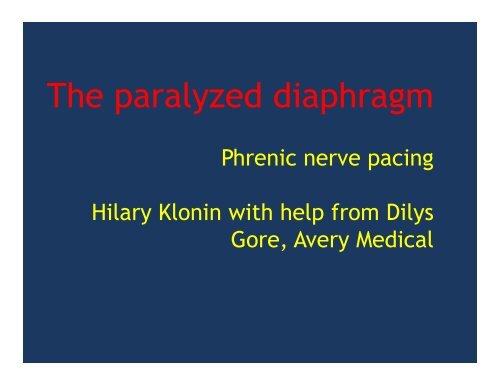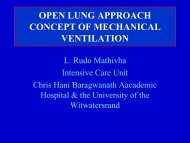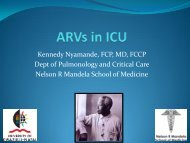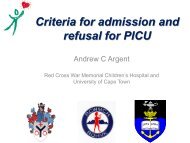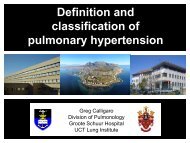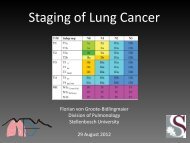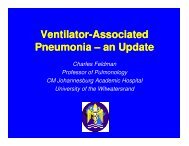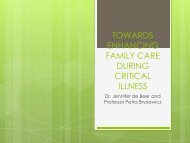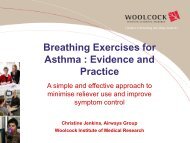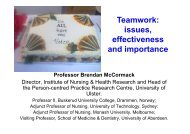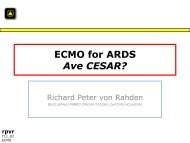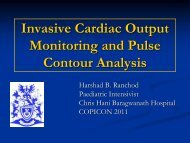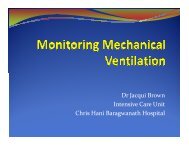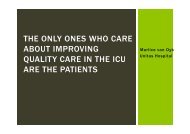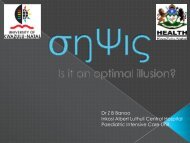The paralyzed diaphragm - Hilary Klonin
The paralyzed diaphragm - Hilary Klonin
The paralyzed diaphragm - Hilary Klonin
You also want an ePaper? Increase the reach of your titles
YUMPU automatically turns print PDFs into web optimized ePapers that Google loves.
<strong>The</strong> <strong>paralyzed</strong> <strong>diaphragm</strong><br />
Phrenic nerve pacing<br />
<strong>Hilary</strong> <strong>Klonin</strong> with help from Dilys<br />
Gore, Avery Medical
CASE-HISTORY<br />
PATIENT TR 23 Year old professional dancer<br />
• Party – Drink- Feels strange - Spiked<br />
Leaves: Difficulty walking – collapses- picked up by EMS<br />
• Admitted to CHBH - GBS<br />
• Admitted to ICU – 48hrs later due to need for ventilation<br />
-Mental function intact<br />
-MRI - Cord oedema/ Inflammation from C1-T6<br />
-Rx for GBS given<br />
• 8 Weeks later no improvement- ventilator dependent<br />
-Repeat MRI – Findings in keeping with “dead cord” C1-T6<br />
-Nerve conduction studies – no function, -can’t pace <strong>diaphragm</strong><br />
- Neuros – irreverssible condition<br />
CASE HISTORY cont’d<br />
• Family counselling<br />
-Canadian friends raising funds for chronic care<br />
facility<br />
- Human Rights Council involvement by<br />
Canadian friends<br />
• 6 months later: medical futility<br />
- socioeconomic background not favorable<br />
- Lives in informal settlement - Electricity<br />
- Family and patient “ready”<br />
• Withdrawal of therapy- death within 10 min
Indications for Diaphragm Pacing<br />
Diaphragm motif
Duchenne 1870’s
•Andrew Ure,1818
Big Names<br />
Glenn<br />
Sarnoff<br />
Avery
Neuromuscular physiology<br />
Respiratory control center located in the<br />
ventral aspects of pons and medulla<br />
Efferent nerves travel down the<br />
corticospinal tracts to synapse with lower<br />
motor neurons at C3-C5<br />
<strong>The</strong> lower motor neurons then stimulate<br />
the <strong>diaphragm</strong>.
Diaphragm muscle fibers<br />
Slow twitch (Type1) fatigue resistant<br />
Fast twitch (Type 2) fatigable
Phrenic Nerve Pacing: Current Concepts<br />
Jorge F. Velazco, Shekhar Ghamande and Salim Surani
Diagnosis<br />
Suspect<br />
Phrenic nerve electromyography<br />
trans<strong>diaphragm</strong>atic pressure<br />
Inspiratory/expiratory chest radiographs<br />
are useful in evaluating patients with<br />
<strong>diaphragm</strong> paralysis.<br />
Sniff testing allows direct visualization of<br />
<strong>diaphragm</strong> motion in response to a<br />
conscious maneuver.
Sniff test
Indications for Diaphragm Pacing<br />
Diaphragm Paralysis<br />
• For those patients who have one or both <strong>diaphragm</strong>s<br />
<strong>paralyzed</strong> and have residual nerve function, a breathing<br />
pacemaker can be considered.
Indications for Diaphragm Pacing<br />
Quadriplegia<br />
• Patients with very high cervical spine injuries involving C3<br />
or higher<br />
• Patients who have lost neurological control of respiration<br />
due to brain stem injuries, strokes, or tumors<br />
• Patients with injuries involving C4 need to pay particular<br />
attention to nerve conduction as the majority of the phrenic<br />
nerve originates at that level.<br />
• Patients with injuries below C4 rarely require ventilatory<br />
support<br />
• Patients with damaged phrenic nerves may be able to<br />
paced in conjunction with peripheral nerve grafts.
Indications for Diaphragm Pacing<br />
Central Sleep Apnea<br />
Congenital central hypoventilation syndrome, or CCHS,<br />
is a rare disorder in which the patient does not have<br />
automatic control of their breathing effort.<br />
•Onset of central sleep apnea can occur later in life as a<br />
result of any number of causes including stroke, brain<br />
injury, and meningitis.<br />
Age 3<br />
• Patients with obstructive sleep apnea, without a central<br />
component, are not appropriate candidates for a<br />
breathing pacemaker.<br />
Age 15
Patient selection<br />
Patients with more limited degrees of<br />
hypoventilation can be managed medically with<br />
noninvasive ventilation, pulmonary<br />
rehabilitation, weight loss, pulmonary toilet,<br />
respiratory stimulants such as theophylline, and<br />
bronchodilators.<br />
Those with more severe degrees of<br />
hypoventilation usually require some form of<br />
mechanical ventilation, which may be<br />
temporary.
Patient selection<br />
High (C1- C3) spinal cord pathology<br />
<br />
<br />
Congenital central hypoventilation syndrome (CCHS)<br />
1/200,000 live births<br />
Upper motor neuron dysfunction<br />
Degenerative neuromuscular conditions
Avery Phrenic Nerve Pacer
Introduction to Diaphragm Pacing<br />
<strong>The</strong> Mark IV Breathing Pacemaker System consists of surgically<br />
implanted receivers and electrodes mated to an external transmitter<br />
by antennas worn over the implanted receivers.<br />
<strong>The</strong> external transmitter and antennas send radiofrequency (RF)<br />
energy to the receivers implanted just under the skin.<br />
<strong>The</strong> receivers then convert the radio waves into stimulating<br />
pulses.<br />
<strong>The</strong>se pulses are sent down the electrodes to the phrenic nerves,<br />
causing <strong>diaphragm</strong> contraction.<br />
This contraction causes inhalation of air. When the pulse train<br />
stops, the <strong>diaphragm</strong>s relax and passive exhalation occurs.<br />
Repetition of these series of pulses produces a normal breathing<br />
pattern.
Breathing pacemakers are not<br />
indicated for patients whose:<br />
phrenic nerves have degenerated, or been<br />
demylenated by a progressive disease.<br />
<strong>diaphragm</strong>s will not respond to electrical<br />
stimulation (i.e., muscular dystrophy or an<br />
eventrated <strong>diaphragm</strong>).<br />
primary diagnosis involves compromised lung<br />
function, such as COPD or emphysema.
CASE-HISTORY<br />
PATIENT TR 23 Year old professional dancer<br />
• Party – Drink- Feels strange - Spiked<br />
Leaves: Difficulty walking – collapses- picked up by EMS<br />
• Admitted to CHBH - GBS<br />
• Admitted to ICU – 48hrs later due to need for ventilation<br />
-Mental function intact<br />
-MRI - Cord oedema/ Inflammation from C1-T6<br />
-Rx for GBS given<br />
• 8 Weeks later no improvement- ventilator dependent<br />
-Repeat MRI – Findings in keeping with “dead cord” C1-T6<br />
-Nerve conduction studies – no function, -can’t pace <strong>diaphragm</strong><br />
- Neuros – irreverssible condition<br />
CASE HISTORY cont’d<br />
• Family counselling<br />
-Canadian friends raising funds for chronic care<br />
facility<br />
- Human Rights Council involvement by<br />
Canadian friends<br />
• 6 months later: medical futility<br />
- socioeconomic background not favorable<br />
- Lives in informal settlement - Electricity<br />
- Family and patient “ready”<br />
• Withdrawal of therapy- death within 10 min
Thoracoscopic
Nerve grafts<br />
Intercostals to phrenic<br />
Spinal accessory nerve to phrenic<br />
Possibility of recovery
Diaphragmatic training<br />
Pacing begins 4 – 6 wks post<br />
implant<br />
1-2hrs/day and slowly increased<br />
over 3-4 months.<br />
<strong>The</strong>se patients may recover muscle<br />
function with reconditioning.
Treatment Device<br />
Phrenic Nerve Pacer<br />
Mixture, some go back onto ventilator<br />
at night<br />
Mechanical Ventilation<br />
Young children may have compliant<br />
chest walls and move onto 24 hour<br />
pacing as they get older
Advantages over PPV<br />
Physiological Advantages<br />
Negative pressure ventilation<br />
• Lower infection rates due to the reduction in<br />
suctioning, elimination of external humidifier<br />
and ventilator circuits, and the potential<br />
removal of the tracheostomy tube.
HEY requires all consultant staff<br />
to be naked below the elbow
Advantages over PPV<br />
Psychological Advantages<br />
• Normal breathing and speech patterns<br />
• Ease of eating and drinking<br />
• Increased patient mobility<br />
• Silent operation<br />
• No face mask or other constrictive device<br />
required.
Advantages over PPV<br />
Financial Advantages<br />
• Breathing pacemakers cost less than $1,000 per year in disposable supplies<br />
(antennas, batteries, etc.) to operate.*<br />
• <strong>The</strong>y do not require the routine<br />
maintenance or variety of disposable<br />
supplies of a mechanical ventilator.<br />
• <strong>The</strong> typical patient is able to<br />
eliminate the rental of a backup<br />
ventilator or other equipment which<br />
can reduce monthly expenditures by<br />
$1,500 - $2,500.<br />
On average, a breathing pacemaker<br />
will pay for itself in 3 years, and save<br />
about $20,000 per year thereafter.<br />
•Hirschfeld S, et al, Spinal Cord; pp 1-5, E-Pub<br />
May 2008.<br />
Avery<br />
Information supplied by
Long term changes to <strong>diaphragm</strong><br />
or phrenic nerve<br />
Electrical<br />
Physiological<br />
Histological
Possible complications<br />
Injury to phrenic nerve<br />
Infection<br />
Atelectasis<br />
Pneumonia<br />
Pneumothorax<br />
Vocal cord prolapse
Possible complications<br />
Electrode failures or dislodgement<br />
Broken or disconnected wires<br />
Cannot use MRI<br />
Muscle injury<br />
Capnothorax<br />
Mechanical failures
Mechanical Ventilation or Phrenic Nerve Stimulation for<br />
Treatment of Spinal Cord Injury-Induced Respiratory<br />
Insufficiency" Spinal Cord. May 2008, Vol. 46, No. 11, pp. 738-<br />
742<br />
64 SCI-RDD patients. 32 patients with functioning<br />
phrenic nerves and <strong>diaphragm</strong> muscles , treated with<br />
PNS<br />
32 patients with destroyed phrenic nerves were<br />
mechanically ventilated.<br />
<br />
Incidence of respiratory infections, significantly<br />
different<br />
Quality of speech is significantly better with PNS<br />
Increased employemnt<br />
Costs paid off in one year
Patient feed back<br />
A recent questionnaire sent to 550 quadriplegic patients<br />
with Avery Breathing Pacemakers. 170 responders:<br />
98% reported satisfaction with Avery and<br />
their Breathing Pacemakers<br />
96% report an improved quality of life<br />
80% report pacing for 12 – 24 hours/day.<br />
80% report improved mobility<br />
70% report improved ability to speak
Probably something we should think about<br />
10 patients have been implanted in South Africa<br />
Memory sticks<br />
Dilys@averybiomedical.com<br />
Dilys Gore
PEDIATRIC AND NEONATAL, NIV MEETING<br />
BARCELONA, SEPTEMBER 2013<br />
I INTERNATIONAL<br />
CONFERENCE<br />
aulapediatria@hsjdbcn.org<br />
Its good to talk<br />
HILARY@LAMA.KAROO.CO.UK


